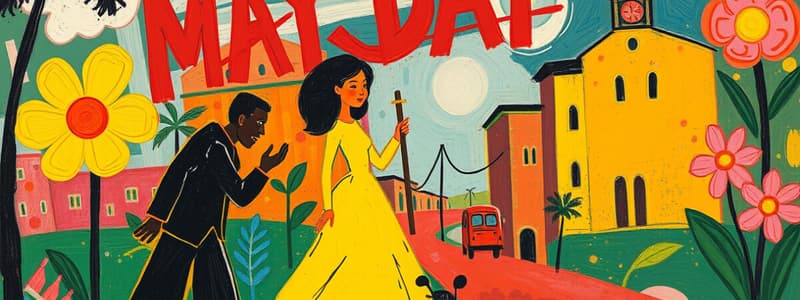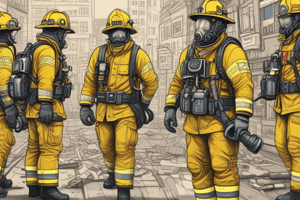Podcast
Questions and Answers
What event were the young men attending before they decided to go out into the night?
What event were the young men attending before they decided to go out into the night?
- A festival celebration
- A wedding ceremony
- A midnight church service
- A ball in their honor (correct)
How did the girls react to the young men's antics outside?
How did the girls react to the young men's antics outside?
- They sighed amorously and expressed envy. (correct)
- They applauded and cheered.
- They ignored them completely.
- They scolded them from their windows.
What were the young men craving to do during the night?
What were the young men craving to do during the night?
- Retire for the evening
- Go serenading and swim in the Pasig (correct)
- Dance more at the ball
- Visit a nearby tavern
What did the old people order regarding the event's end time?
What did the old people order regarding the event's end time?
What atmosphere is created by the descriptions of the surroundings during the evening?
What atmosphere is created by the descriptions of the surroundings during the evening?
What did old Anastasia do in reaction to the girls' behavior?
What did old Anastasia do in reaction to the girls' behavior?
Which phrase best describes the young men's demeanor as they enjoyed the evening?
Which phrase best describes the young men's demeanor as they enjoyed the evening?
What sounds accompanied the watchman's presence in the narrative?
What sounds accompanied the watchman's presence in the narrative?
What motivates Agueda to leave the room and go outside?
What motivates Agueda to leave the room and go outside?
How does Agueda perceive the room when she first enters it?
How does Agueda perceive the room when she first enters it?
What did Dona Agueda see in the mirror?
What did Dona Agueda see in the mirror?
What does Agueda see when she looks into the mirror?
What does Agueda see when she looks into the mirror?
How did Dona Agueda describe the devil's scar?
How did Dona Agueda describe the devil's scar?
What type of mustaches did Dona Agueda attribute to the devil?
What type of mustaches did Dona Agueda attribute to the devil?
What effect does the incantation have on Agueda?
What effect does the incantation have on Agueda?
What does Dona Agueda focus on while her daughter speaks?
What does Dona Agueda focus on while her daughter speaks?
What did the devil say about Dona Agueda's charms?
What did the devil say about Dona Agueda's charms?
What action did Dona Agueda take when confronted by the devil in the mirror?
What action did Dona Agueda take when confronted by the devil in the mirror?
What is the atmosphere of the setting described in the passage?
What is the atmosphere of the setting described in the passage?
What can be inferred about Agueda's character based on her actions?
What can be inferred about Agueda's character based on her actions?
What was the relationship between Dona Agueda and Badoy Montiya?
What was the relationship between Dona Agueda and Badoy Montiya?
Which dance did the devil want to perform with Dona Agueda?
Which dance did the devil want to perform with Dona Agueda?
How does the description of the antique mirror contribute to the overall mood?
How does the description of the antique mirror contribute to the overall mood?
How did Dona Agueda feel when she first saw the devil in the mirror?
How did Dona Agueda feel when she first saw the devil in the mirror?
What did the boy in the story hope to see in the mirror?
What did the boy in the story hope to see in the mirror?
How did Don Badoy react to the boy's curiosity about the mirror?
How did Don Badoy react to the boy's curiosity about the mirror?
What past experience did Don Badoy share with the boy regarding a witch?
What past experience did Don Badoy share with the boy regarding a witch?
What was the boy's initial reaction to his grandfather's warning about witches?
What was the boy's initial reaction to his grandfather's warning about witches?
What did Don Badoy describe the witch he encountered as?
What did Don Badoy describe the witch he encountered as?
What lesson did Don Badoy try to convey through his story to the boy?
What lesson did Don Badoy try to convey through his story to the boy?
What emotion did Don Badoy exhibit while recounting his tale of the witch?
What emotion did Don Badoy exhibit while recounting his tale of the witch?
What is the overall tone of the conversation between the boy and his grandfather?
What is the overall tone of the conversation between the boy and his grandfather?
What was Grandma's association with the mirror?
What was Grandma's association with the mirror?
How is Agueda described in her final moments?
How is Agueda described in her final moments?
What emotion does Don Badoy feel upon remembering Agueda?
What emotion does Don Badoy feel upon remembering Agueda?
What imagery is used to describe the street outside?
What imagery is used to describe the street outside?
What does the 'evil old moon' symbolize in the passage?
What does the 'evil old moon' symbolize in the passage?
What sound signals the time in the passage?
What sound signals the time in the passage?
How is the weather described in the content?
How is the weather described in the content?
What does the phrase 'tiresome pranks of the earth' likely refer to?
What does the phrase 'tiresome pranks of the earth' likely refer to?
Flashcards are hidden until you start studying
Study Notes
Setting and Atmosphere
- Takes place during a May Day Eve celebration, a time of revelry and enchantment.
- The scene conveys a tropical night filled with excitement and a hint of danger, emphasizing the contrast between joyous celebration and ominous undertones.
Characters
- Young men: Recently returned from Europe, embody youth's arrogance and exuberance; eager for adventure and mischief.
- Agueda: A central character, embodying youthful innocence and curiosity; she transitions from a lively girl to a weary adult haunted by past choices.
- Don Badoy Montiya: An older character embodying experience; he reflects on his youthful encounters and serves as a cautionary figure.
Themes
- The struggle between innocence and corruption: Young girls' dreams of love clash with the harsh realities presented by their older counterparts.
- The power and danger of mirrors: Act as catalysts for self-reflection and the revelation of truth, as characters confront their fears and desires.
Symbolism
- Mirrors: Represents self-perception and the confrontation of one's fears. They serve as portals to the past and future, revealing both beauty and horror.
- The night: Serves as a character in itself, full of temptation and deceit, symbolizing the duality of human experience.
Key Events
- The festivities culminate at midnight when young men and women are drawn outside despite the warnings of the elderly.
- Agueda’s encounter with the mirror acts as a pivotal moment, symbolizing a choice between the allure of youth and the dangers that accompany it.
- Dialogue between characters across generations highlights the cyclical nature of experience and the wisdom gained from mistakes.
Tone and Mood
- Initial celebration transitions to tension and foreboding as characters delve into deeper themes of love, loss, and regret.
- The final scenes evoke a sense of melancholy and reflection as characters confront the consequences of their choices, illustrating the weight of time on youth.
Conclusion
- The narrative highlights the theme of unattainable desires—dreams of love and the consequences of recklessness.
- Ends with a chilling reminder of mortality and the enduring impact of youthful decisions, as portrayed through the contrast between past and present.
Studying That Suits You
Use AI to generate personalized quizzes and flashcards to suit your learning preferences.




